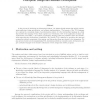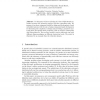89 search results - page 3 / 18 » Engineering self-coordinating software intensive systems |
ICSM
2000
IEEE
13 years 10 months ago
2000
IEEE
Several reverse engineering methods for recovering objects from legacy systems have been proposed in the literature, but most of them neglect to identify the relationships among t...
SEKE
1993
Springer
13 years 9 months ago
1993
Springer
1 To handle the complexity of modern software systems, a software comprehension strategy pointing out the al abstraction level is necessary. In this context, the role of technology...
DBPL
1989
Springer
13 years 9 months ago
1989
Springer
In the process of developing an Information System, one passes through stages that include requirements gathering, design specification, and software implementation. The purpose ...
CBSE
2008
Springer
13 years 7 months ago
2008
Springer
Abstract. In this paper we focus on design of a class of distributed embedded systems that primarily perform real-time controlling tasks. We propose a two-layer component model for...
CODES
2000
IEEE
13 years 10 months ago
2000
IEEE
In this paper, we propose a novel storage requirement estimation methodology for use in the early system design phases when the data transfer ordering is only partly fixed. At tha...


